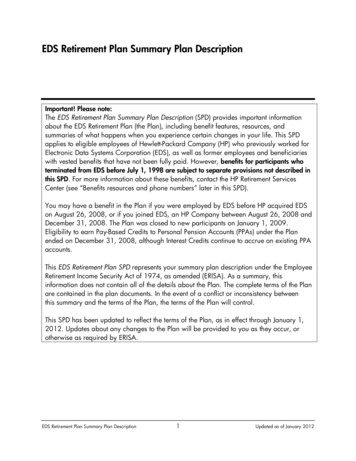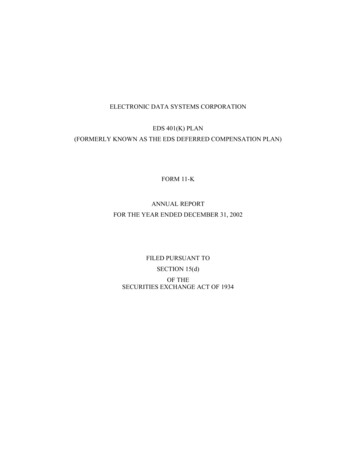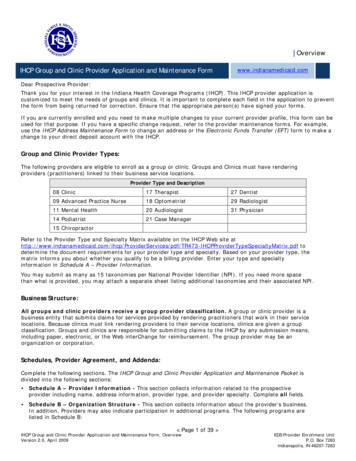
Transcription
Reprinted from: Trends in new crops and new uses. 2002. J. Janickand A. Whipkey (eds.). ASHS Press, Alexandria, VA.Hemp: A New Crop with New Uses for North America*Ernest Small and David Marcus“Hemp” refers primarily to Cannabis sativa L. (Cannabaceae), although the term has been applied todozens of species representing at least 22 genera, often prominent fiber crops. For examples, Manila hemp(abaca) is Musa textilis Née, sisal hemp is Agave sisalina Perrine, and sunn hemp is Crotolaria juncea L.Especially confusing is the phrase “Indian hemp,” which has been used both for narcotic Asian land races ofC. sativa (so-called C. indica Lamarck of India) and Apocynum cannabinum L., which was used by NorthAmerican Indians as a fiber plant. Cannabis sativa is a multi-purpose plant that has been domesticated forbast (phloem) fiber in the stem, a multi-purpose fixed oil in the “seeds” (achenes), and an intoxicating resinsecreted by epidermal glands. The common names hemp and marijuana (much less frequently spelled marihuana) have been applied loosely to all three forms, although historically hemp has been used primarily forthe fiber cultigen and its fiber preparations, and marijuana for the drug cultigen and its drug preparations. Thecurrent hemp industry is making great efforts to point out that “hemp is not marijuana.” Italicized, Cannabisrefers to the biological name of the plant (only one species of this genus is commonly recognized, C. sativaL.). Non-italicized, “cannabis” is a generic abstraction, widely used as a noun and adjective, and commonly(often loosely) used both for cannabis plants and/or any or all of the intoxicant preparations made from them.Probably indigenous to temperate Asia, C. sativa is the most widely cited example of a “camp follower.”It was pre-adapted to thrive in the manured soils around man’s early settlements, which quickly led to itsdomestication (Schultes 1970). Hemp was harvested by the Chinese 8500 years ago (Schultes and Hofmann1980). For most of its history, C. sativa was most valued as a fiber source, considerably less so as an intoxicant, and only to a limited extent as an oilseed crop. Hemp is one of the oldest sources of textile fiber, withextant remains of hempen cloth trailing back 6 millennia. Hemp grown for fiber was introduced to westernAsia and Egypt, and subsequently to Europe somewhere between 1000 and 2000 BCE. Cultivation in Europebecame widespread after 500 CE. The crop was first brought to South America in 1545, in Chile, and to NorthAmerica in Port Royal, Acadia in 1606. The hemp industry flourished in Kentucky, Missouri, and Illinoisbetween 1840 and 1860 because of the strong demand for sailcloth and cordage (Ehrensing 1998). From theend of the Civil War until 1912, virtually all hemp in the US was produced in Kentucky. During World War I,some hemp cultivation occurred in several states, including Kentucky, Wisconsin, California, North Dakota,South Dakota, Minnesota, Indiana, Illinois, Ohio, Michigan, Kansas, and Iowa (Ehrensing 1998). The secondworld war led to a brief revival of hemp cultivation in the Midwest, as well as in Canada, because the war cutoff supplies of fiber (substantial renewed cultivation also occurred in Germany for the same reason). Until thebeginning of the 19th century, hemp was the leading cordage fiber. Until the middle of the 19th century, hemprivaled flax as the chief textile fiber of vegetable origin, and indeed was described as “the king of fiber-bearing plants,—the standard by which all other fibers are measured” (Boyce 1900). Nevertheless, the MarihuanaTax Act applied in 1938 essentially ended hemp production in the United States, although a small hemp fiberindustry continued in Wisconsin until 1958. Similarly in 1938 the cultivation of Cannabis became illegal inCanada under the Opium and Narcotics Act.Hemp, grown under license mostly in Canada, is the most publicized “new” crop in North America.Until very recently the prohibition against drug forms of the plant prevented consideration of cultivation offiber and oilseed cultivars in Canada. However, in the last 10 years three key developments occurred: (1)much-publicized recent advances in the legal cultivation of hemp in western Europe, especially for new valueadded products; (2) enterprising farmers and farm groups became convinced of the agricultural potential ofhemp in Canada, and obtained permits to conduct experimental cultivation; and (3) lobby groups convincedthe government of Canada that narcotic forms of the hemp plant are distinct and distinguishable from fiberand oilseed forms. In March 1998, new regulations (under the Controlled Drugs and Substances Act) wereprovided to allow the commercial development of a hemp industry in Canada, and since then more than athousand licenses have been issued. Hectares licensed for cultivation for 1998–2001 were respectively, 2,500,*This paper was considerably improved by criticism provided by A. McElroy.284
Fibers14,200, 5,487, and 1,355, the decreasing trend due to a glut of seed produced in 1999 and pessimism over newpotential regulations barring exports to the US. Information on the commercial potential of hemp in Canada isin Blade (1998), Marcus (1998), and Pinfold Consulting (1998). In the US, a substantial trade in hemp products has developed, based on imports of hemp fiber, grain, and oil. The American agricultural community hasobserved this, and has had success at the state level in persuading legislators of the advisability of experimental hemp cultivation as a means of evaluating the wisdom of re-establishing American hemp production. However, because of opposition by the federal government, to date there has only been a small experimental plot inHawaii. Information on the commercial potential of hemp in the US is presented in the following.Cannabis sativa is extremely unusual in the diversity of products for which it is or can be cultivated.Popular Mechanics magazine (1938) touted hemp as “the new billion dollar crop,” stating that it “can be usedto produce more than 25,000 products, ranging from dynamite to Cellophane.” Table 1 presents the principalproducts for which the species is cultivated in Europe, all of which happen to be based on fiber. This presentation stresses the products that hold the most promise for North America, which also include a considerablerange of oilseed applications (Table 2; Fig. 1).BASIC CATEGORIES OF CANNABIS AND THEIR FIELD ARCHITECTURECannabis sativa is an annual wind-pollinated plant, normally dioecious and dimorphic, although sometimes monoecious (mostly in several modern European fiber cultivars). Figure 2 presents the basic morphology of the species. Some special hybrids, obtained by pollinating females of dioecious lines with pollen fromTable 1. Hemp fiber usage in the European Union in 1999 (after Karus et al. 2000).Class of productQuantity 9523465026,821640.82.2100Specialty pulp (cigarette paper, bank notes, technical filters,and hygiene products)Composites for autosConstruction & thermal insulation materialsGeotextilesOtherTotalTable 2. Analysis of commercial Cannabis product potential in North America in order of decreasing valuetoward the right and toward the bottom.Woody stem coreFemale floral(perigonal) bract“Seeds” (achenes)Long (“bark”) fiberConfectionary, bakedgoodsSalad oilBody care“cosmetics”Animal food (wholeseeds for birds, presscake for mammalianlivestock)Gamma-linolenic aciddietary supplementsSpecialty industrial oilsPlastic-molded products Animal beddingMedicinalSpecialty papersThermal insulationcannabinoidsConstruction fiberboard ConstructionEssential oil (forBiodegradable landscape(fiberboard, plaster flavor & perfume)matting & plant cultureboard, etc.)Insect repellantproductsCoarse textiles (carpets,upholstery)Fine textiles285WholeplantAlcoholFuelSilage
Trends in New Crops and New Usesmonoecious plants, are predominantly female (so-called “all-female,” these generally also produce some hermaphrodites and occasional males). All-female lines are productive for some purposes (e.g. they are veryuniform, and with very few males to take up space they can produce considerable grain), but the hybrid seed isexpensive to produce. Staminate or “male” plants tend to be 10%–15% taller and are less robust than thepistillate or “female” (note the comparatively frail male in Fig. 3). So prolific is pollen production that anisolation distance of about 5 km is usually recommended for generating pure-bred foundation seed. A “perigonalbract” subtends each female flower, and grows to envelop the fruit. While small, secretory, resin-producingglands occur on the epidermis of most of the above-ground parts of the plant, the glands are very dense andproductive on the perigonal bracts, which are accordingly of central interest in marijuana varieties. The rootis a laterally branched taproot, generally 30–60 cm deep, up to 2.5 m in loose soils, very near the surface andmore branched in wet soils. Extensive root systems are key to the ability of hemp crops to exploit deep supplies of nutrients and water. The stems are erect, furrowed, and usually branched, with a woody interior, andmay be hollow in the internodes. Although the stem is often woody, the species is frequently referred to as aherb or forb. Plants vary enormously in height depending on genetic constitution and environment (Fig. 4),but are typically 1–5 m (heights of 12 m or more in cultivation have been claimed).Fig. 1. Major uses of industrial hemp.286
FibersThere is great variation in Cannabis sativa, because of disruptive domestication for fiber, oilseed, andnarcotic resin, and there are features that tend to distinguish these three cultigens (cultivated phases) fromeach other. Moreover, density of cultivation is used to accentuate certain architectural features. Figure 5illustrates the divergent appearances of the basic agronomic categories of Cannabis in typical field configurations.Fig. 2. Cannabis sativa. This superb composite plate by artist Elmer Smith, often reproduced at a very smallscale and without explanation in marijuana books, is the best scientific illustration of the hemp plant everprepared. 1. Flowering branch of male plant. 2. Flowering branch of female plant. 3. Seedling. 4. Leaflet. 5.Cluster of male flowers. 6. Female flower, enclosed by perigonal bract. 7. Mature fruit enclosed in perigonalbract. 8. Seed (achene), showing wide face. 9. Seed, showing narrow face. 10. Stalked secretory gland. 11.Top of sessile secretory gland. 12. Long section of cystolith hair (note calcium carbonate concretion at base).Reproduced with the permission of Harvard University, Cambridge, MA.287
Trends in New Crops and New UsesHighly selected forms of the fiber cultigen possess features maximizing fiber production. Since the nodestend to disrupt the length of the fiber bundles, thereby limiting quality, tall, relatively unbranched plants withlong internodes have been selected. Another strategy has been to select stems that are hollow at the internodes, with limited wood, since this maximizes production of fiber in relation to supporting woody tissues.Similarly, limited seed productivity concentrates the plant’s energy into production of fiber, and fiber cultivarsoften have low genetic propensity for seed output. Selecting monoecious strains overcomes the problem ofdifferential maturation times and quality of male (staminate) and female (pistillate) plants (males mature 1–3weeks earlier). Male plants in general are taller, albeit slimmer, less robust, and less productive. Except forthe troublesome characteristic of dying after anthesis, male traits are favored for fiber production, in contrastto the situation for drug strains noted below. In former, labor-intensive times, the male plants were harvestedearlier than the females, to produce superior fiber. The limited branching of fiber cultivars is often compensated for by possession of large leaves with wide leaflets, which obviously increase the photosynthetic abilityof the plants. Since fiber plants have not generally been selected for narcotic purposes, the level of intoxicating constituents is usually limited.Fig. 3. Photograph of Cannabis sativa. Left, Fig. 4. United States National Institute of Health, Universitystaminate (“male”) plant in flower; right, pis- of Mississippi marijuana plantation site, showing variation inplant size. A tall fiber-type of hemp plant is shown at left,tillate (“female”) plant in flower.and a short narcotic variety (identified as “Panama Gold”) atright.Fig. 5. Typical architecture of categories of cultivated Cannabis sativa. Top left: narcotic plants are generally low, highlybranched, and grown well-spaced. Top right: plants grown foroilseed were traditionally well-spaced, and the plants developedmedium height and strong branching. Bottom left: fiber cultivars are grown at high density, and are unbranched and verytall. Bottom center: “dual purpose” plants are grown at moderate density, tend to be slightly branched and of medium to tallheight. Bottom right: some recent oilseed cultivars are grownat moderate density and are short and relatively unbranched.Degree of branching and height are determined both by the density of the plants and their genetic background.288
FibersAn absence of such fiber-strain traits as tallness, limited branching, long internodes, and very hollowstems, is characteristic of narcotic strains. Drug forms have historically been grown in areas south of thenorth-temperate zone, often close to the equator, and are photoperiodically adapted to a long season. Whengrown in north-temperate climates maturation is much-delayed until late fall, or the plants succumb to coldweather before they are able to produce seeds. Unlike fiber strains that have been selected to grow well atextremely high densities, drug strains tend to be less persistent when grown in high concentration (de Meijer1994). Drug strains can be very similar in appearance to fiber strains. However, a characteristic type ofnarcotic plant was selected in southern Asia, particularly in India and neighboring countries. This is dioecious, short (about a meter in height), highly branched, with large leaves (i.e. wide leaflets), and it is slow tomature. The appearance is rather like a short, conical Christmas tree.Until recent times, the cultivation of hemp primarily as an oilseed was largely unknown, except in Russia. Today, it is difficult to reconstruct the type of plant that was grown there as an oilseed, because suchcultivation has essentially been abandoned. Oilseed hemp cultivars in the modern sense were not availableuntil very recently, but some land races certainly were grown specifically for seeds in Russia. Dewey (1914)gave the following information: “The short oil-seed hemp with slender stems, about 30 inches high, bearingcompact clusters of seeds and maturing in 60 to 90 days, is of little value for fiber production, but the experimental plants, grown from seed imported from Russia, indicate that it may be valuable as an oil-seed crop tobe harvested and threshed in the same manner as oil-seed flax.” Most hemp oilseed in Europe is currentlyobtained from so-called “dual usage” plants (employed for harvest of both stem fiber and seeds, from thesame plants). Of the European dual-usage cultivars, ‘Uniko B’ and ‘Fasamo’ are particularly suited to beinggrown as oilseeds. Very recently, cultivars have been bred specifically for oilseed production. These include‘Finola,’ formerly known as ‘Fin-314’ (Fig. 6) and ‘Anka’ (Fig. 7), which are relatively short, little-branched,mature early in north-temperate regions, and are ideal for high-density planting and harvest with conventionalequipment. Dewey (1914) noted that a Turkish narcotic type of land race called “Smyrna” was commonlyused in the early 20th century in the US to produce birdseed, because (like most narcotic types of Cannabis) itis densely branched, producing many flowers, hence seeds. While oilseed land races in northern Russia wouldhave been short, early-maturing plants in view of the short growing season, in more southern areas oilseedlandraces likely had moderate height, and were spaced more widely to allow abundant branching and seedproduction to develop. Until Canada replaced China in 1998 as a source of imported seeds for the US, mostseeds used for various purposes in the US were sterilized and imported from China. Indeed, China remainsthe largest producer of hempseed. We have grown Chinese hemp land races, and these were short, branched,adapted to a very long growing season (i.e. they come into flower very slowly in response to photoperiodicFig. 6. ‘Finola,’ the first cultivar of Cannabis sativa Fig. 7. ‘Anka,’ the first registered North Americanbred exclusively for grain. (Courtesy of the breeder, bred cultivar of Cannabis sativa. This variety is bestJ.C. Callaway, Univ. Kuopio, Finland.)suited for grain production. (Courtesy of the breeder,P. Dragla, and of the Industrial Hemp Seed Development Company, Chatham, Ontario.)289
Trends in New Crops and New Usesinduction of short days in the fall), and altogether they were rather reminiscent of Dewey’s description ofSmyrna. Although similar in appearance to narcotic strains of C. sativa, the Chinese land races we grew werein fact low in intoxicating constituents, and it may well be that what Dewey thought was a narcotic strain wasnot. Although some forms of C. sativa have quite large seeds, until recently oilseed forms appear to havebeen mainly selected for a heavy yield of seeds, usually recognizable by abundant branching. Such forms aretypically grown at lower densities than hemp grown only for fiber, as this promotes branching, although itshould be understood that the genetic propensity for branching has been selected. Percentage or quality of oilin the seeds does not appear to have been important in the past, although selection for these traits is now beingconducted. Most significantly, modern selection is occurring with regard to mechanized harvesting, particularly the ability to grow in high density as single-headed stalks with very short branches bearing considerableseed.CONTROLLING THE DRUG ABUSE POTENTIAL OF HEMPAs detailed below, the development of hemp as a new legal crop in North America must be considered inrelation to illicit cultivation, so it is important to appreciate the scope of the drug situation. Up until the firsthalf of the 20th century, drug preparations of Cannabis were used predominantly as a recreational inebriant inpoor countries and the lower socio-economic classes of developed nations. After World War II, marijuanabecame associated with the rise of a hedonistic, psychedelic ethos, first in the United States and eventuallyover much of the world, with the consequent development of a huge international illicit market that exceedsthe value of the hemp market during its heyday. Table 3 shows the “economic significance” (dollars generated in the black market plus dollar cost of control measures) of the illicit drug industry associated with C.sativa, and contrasts this with the estimated dollar value of major categories of legitimate uses. In the Netherlands, the annual value of narcotic hemp cultivation (ca. 10 billion) exceeds the value of tulips (Collins 1999).Marijuana has become the most widely disseminated illicit species in the world (Schultes and Hofmann 1980).With the exception of alcohol, it is the most widely used recreational euphoric drug. About 25% of NorthAmericans are believed to have used Cannabis illegally. According to the US National Institute on DrugAbuse (www.nida.nih.gov/Infofax/marijuana.html), more than 72 million Americans (33%) 12 years of ageand older have tried marijuana. Cultivation, commerce, and consumption of drug preparations of Cannabishave been proscribed in most countries during the present century. The cost of enforcing the laws againstCannabis in North America is in the billions of dollars annually. In addition, there are substantial social costs,such as adverse effects on users, particularly those who are convicted. Tragically this includes some legitimate farmers who, faced with financial ruin because of the unprofitability of crops being grown, converted togrowing marijuana.A rather thorough analysis of the scope of the illicit marijuana industry in Canada for 1998 is reported ana and summarized in MacLeod (1999). At least 800tonnes (t) of marijuana were grown in Canada in 1998, representing a harvest of 4.7 million flowering plants.More than 50% of the marijuana available in Canada is grown domestically. An average mature plant wasestimated to produce 170 g of “marketable substance.” The value of the Canadian crop is uncertain, but hasbeen estimated to be in the billions of dollars annually (Heading 1998; MacLeod 1999).Table 3. Comparative annual world economic significance of categories of Cannabis activity.CategoryWorld ( )North America ( ) Type of investmentRecreational drugsIndustrial hempTherapeutic drugsPhytoremediationOrnamental hemp 1 trillion100s of millionsz100s of millions10s of thousandsthousands100s of billions10s of millions10s of millionsnilnilzLaw enforcement, eradication, educationProduction, development, marketing, researchProduction, development, marketing, researchResearchDevelopment“The global market for hemp-derived products is valued at between 100 million and 200 million annually”(Pinfold Consulting 1998; De Guzman 2001).290
FibersThe US Drug Enforcement Administration’s online criminal justice statistics for .pdf) shows the following seizures and eradication of plantsof C. sativa: 40,929 outdoor plots (2,597,796 plants), 139,580,728 ditchweed (ruderal plants), 2,361 indooroperations (217,105 plants), for a grand total of 2,814, 903 plants destroyed. Impressively, the species wasgrown in all 50 states (including outdoor seizures in every state except Wyoming)! It is of course impossibleto know exactly how much marijuana is cultivated in the United States, and perhaps only 10% to 20% of theamount grown is seized. The profitability of the illegal crop is indicated by a comparison of the cost of abushel of corn (roughly 2.50) and a bushel of manicured marijuana (about 70,000; it has been suggestedthat prices range from 500 a pound, for low-quality marijuana, to more than 5,000 a pound for “boutique”strains like “Northern Lights” and “Afghan Kush”). According to a National Organization for the Reform ofMarijuana Laws (NORML) (mir.drugtext.org/marijuananews/marijuana ranks fourth largest c.htm) marijuanais at least the fourth most valuable crop in America, outranked only by corn, soybeans, and hay. It was estimated that 8.7 million marijuana plants were harvested in 1997, worth 15.1 billion to growers and 25.2billion on the retail market (the wholesale value was used to compare marijuana to other cash crops). Marijuana was judged to be the largest revenue producing crop in Alabama, California, Colorado, Hawaii, Kentucky, Maine, Rhode Island, Tennessee, Virginia, and West Virginia, and one of the top five cash crops in 29other states.Cannabis contains a seemingly unique class of chemicals, the cannabinoids, of which more than 60 havebeen described, but only a few are psychoactive. Cannabinoids are produced in specialized epidermal glands,which differ notably in distribution on different organs of the plant (high concentrations occur on the uppersurface of the young leaves and young twigs, on the tepals, stamens, and especially on the perigonal bract).Given this distribution, the glands would seem to be protective of young and reproductive above-ground tissues (the roots lack glands). Two classes of epidermal glands occur—stalked and sessile (Fig. 8), but in eithercase the glandular cells are covered by a sheath under which resin is accumulated, until the sheath ruptures,releasing resin on the surface. The resin is a sticky mixture of cannabinoids and a variety of terpenes. Thecharacteristic odor of the plant is due to the abundant terpenes, which are not psychoactive. The more important cannabinoids are shown in Fig. 9. In the plant the cannabinoids exist predominantly in the form of car-Fig. 8. Scanning electron micrographs of the abaxialsurface of a perigonal bract (which envelops the fruit).These bracts are the most intoxicating part of theplant, and may contain 20% THC, dry weight. Theresin is synthesized both in stalked and sessile glands.Multicellular secretory glands (of phallic appearance),some broken stalks of these (note cellular appearance), and unicellular cystolith hairs (claw-like structures) are pictured.Fig. 9. Some important cannabinoids of cannabis resin. 9-THC (delta-9 tetrahydrocannabinol) is the chief intoxicant chemical and predominates in intoxicant strains,while the isomer 8-THC is usually present in no morethan trace amounts. CBD (cannabidiol) is the chief nonintoxicant chemical, and predominates in non-intoxicantstrains; it has sedative effects. The non-intoxicant CBN(cannabinol) is a frequent degradation or oxidation product. The non-intoxicant cannabichromene (CBC) is typically found in trace amounts in intoxicant strains. Thenon-intoxicant cannabigerol (CBG) is considered to bea precursor of the other cannbinoids (see Fig. 10).291
Trends in New Crops and New Usesboxylic acids, which decarboxylate with time or when heated. Delta-9-tetrahydrocannabinol ( 9-THC, or simplyTHC) is the predominant psychoactive component. Other THC isomers also occur, particularly 8-THC, whichis also psychoactive. Technically, the euphoric psychological effects of THC are best described by the wordpsychotomimetic. Cannabidiol (CBD) is the chief non-psychotomimetic cannabinoid. A THC concentrationin marijuana of approximately 0.9% has been suggested as a practical minimum level to achieve the (illegal)intoxicant effect, but CBD (the predominant cannabinoid of fiber and oilseed varieties) antagonizes (i.e. reduces) the effects of THC (Grotenhermen and Karus 1998). Concentrations of 0.3% to 0.9% are consideredto have “only a small drug potential” (Grotenhermen and Karus 1998). Some cannabinoid races have beendescribed, notably containing cannabichromene (particularly in high-THC forms) and cannabigerol monomethylether (in some Asian strains). The biosynthetic pathways of the cannabinoids are not yet satisfactorily elucidated, although the scheme shown in Fig. 10 is commonly accepted. At least in some strains, THC is derivedfrom cannabigerol, while in others it may be derived from CBD. CBN and 8-THC are considered to bedegradation products or analytical artifacts (Pate 1998a).Both in Canada and the US, the most critical problem to be addressed for commercial exploitation of C.sativa is the possible unauthorized drug use of the plant. Indeed, the reason hemp cultivation was made illegalin North America was concern that the hemp crop was a drug menace. The drug potential is, for practicalpurposes, measured by the presence of THC. THC is the world’s most popular illicit chemical, and indeed thefourth most popular recreational drug, after caffeine, alcohol, and nicotine. “Industrial hemp” is a phrase thathas become common to designate hemp used for commercial non-intoxicant purposes. Small and Cronquist(1976) split C. sativa into two subspecies: C. sativa subsp. sativa, with less than 0.3% (dry weight) of THC inthe upper (reproductive) part of the plant, and C. sativa subsp. indica (Lam.) E. Small & Cronq. with morethan 0.3% THC. This classification has since been adopted in the European Community, Canada, and parts ofAustralia as a dividing line between cultivars that can be legally cultivated under license and forms that areconsidered to have too high a drug potential. For a period, 0.3% was also the allowable THC content limit forcultivation of hemp in the Soviet Union. In the US, Drug Enforcement Agency guidelines issued Dec. 7, 1999expressly allowed products with a THC content of less than 0.3% to enter the US without a license; but subsequently permissible levels have been a source of continuing contention. Marijuana in the illicit market typically has a THC content of 5% to 10% (levels as high as 25% have been reported), and as a point of interest, acurrent Canadian government experimental medicinal marijuana production contract calls for the productionof 6% marijuana. As noted above, a level of about 1% THC is considered the threshold for marijuana to haveintoxicating potential, so the 0.3% level is conservative, and some countries (e.g. parts of Australia, Switzerland) have permitted the cultivation of cultivars with higher levels. It should be appreciated that there isconsiderable variation in THC content in different parts of the plant. THC content increases in the followingorder: achenes (excluding bracts), roots, large stems, smaller stems, older and larger leaves, younger and smallerleaves, flowers, perigonal bracts covering both the female flowers and fruits. It is well known in the illicittrade how to screen off the more potent fractions of the plant in order to increaseTHC levels in resultant drug products. Nevertheless, a level of 0.3% THC in theflowering parts of the plant is reflective of material that is too low in intoxicantpotential to actually be used practically for illicit production of marijuana or othertypes of cannabis drugs. Below, the problem of permissible levels of THC infood products made from hempseed is discussed.There is a general inverse relationship in the resin of Cannabis between theamounts of THC present and the amount of the other principal cannabinoid, CBD.Whereas most drug strains contain primarily THC and little or no CBD, fiber andoilseed strains primarily contain CBD and very little THC. CBD can be converted to THC by acid catalyzed cyclization, and so
scale and without explanation in marijuana books, is the best scientific illustration of the hemp plant ever prepared. 1. Flowering branch of male plant. 2. Flowering branch of female plant. 3. Seedling. 4. Leaflet. 5. Cluster of male flowers. 6. Female flower, enclosed by perigon










